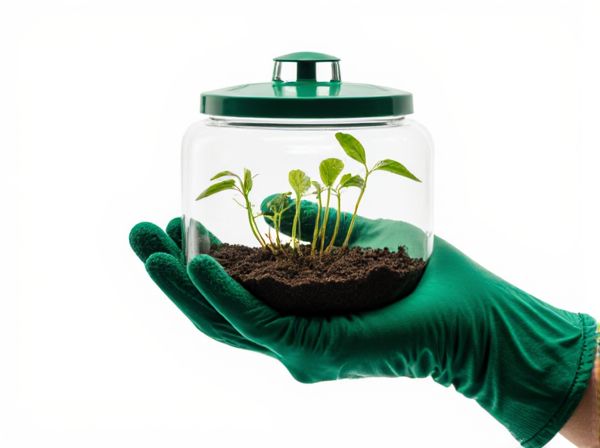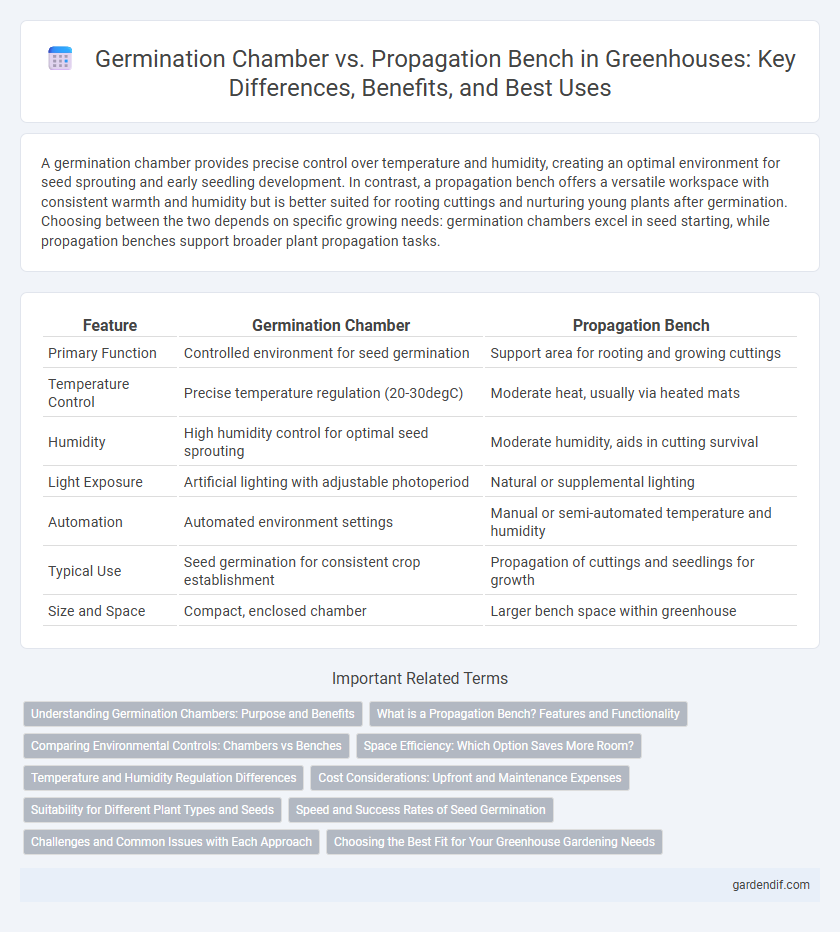
Germination Chamber vs Propagation Bench Illustration
A germination chamber provides precise control over temperature and humidity, creating an optimal environment for seed sprouting and early seedling development. In contrast, a propagation bench offers a versatile workspace with consistent warmth and humidity but is better suited for rooting cuttings and nurturing young plants after germination. Choosing between the two depends on specific growing needs: germination chambers excel in seed starting, while propagation benches support broader plant propagation tasks.
Table of Comparison
| Feature | Germination Chamber | Propagation Bench |
|---|---|---|
| Primary Function | Controlled environment for seed germination | Support area for rooting and growing cuttings |
| Temperature Control | Precise temperature regulation (20-30degC) | Moderate heat, usually via heated mats |
| Humidity | High humidity control for optimal seed sprouting | Moderate humidity, aids in cutting survival |
| Light Exposure | Artificial lighting with adjustable photoperiod | Natural or supplemental lighting |
| Automation | Automated environment settings | Manual or semi-automated temperature and humidity |
| Typical Use | Seed germination for consistent crop establishment | Propagation of cuttings and seedlings for growth |
| Size and Space | Compact, enclosed chamber | Larger bench space within greenhouse |
Understanding Germination Chambers: Purpose and Benefits
Germination chambers provide a controlled environment with precise temperature, humidity, and light conditions essential for seed sprouting and uniform germination rates. These chambers minimize environmental stress, reducing the risk of fungal infections and improving seedling vigor compared to propagation benches. Utilizing germination chambers enhances seedling quality and accelerates the early growth phase critical for successful greenhouse crop production.
What is a Propagation Bench? Features and Functionality
A propagation bench in a greenhouse is a specialized platform designed for optimal seedling and cutting growth, featuring adjustable heating elements to maintain ideal soil temperatures for germination and root development. It often incorporates a water reservoir or misting system to sustain consistent humidity levels, promoting healthy propagation conditions. Enhanced airflow and sturdy construction support disease prevention and facilitate easy plant management during early growth stages.
Comparing Environmental Controls: Chambers vs Benches
Germination chambers provide precise environmental controls such as temperature, humidity, and light intensity, ensuring consistent and optimal conditions for seed sprouting. Propagation benches offer adjustable but less exact control, relying on overhead systems and manual settings that may cause variability in microclimates. The controlled environment of germination chambers significantly enhances seed viability and uniformity compared to the more variable conditions found on propagation benches.
Space Efficiency: Which Option Saves More Room?
A germination chamber offers superior space efficiency by providing controlled conditions in a compact, vertical design that maximizes limited greenhouse areas. Propagation benches require more horizontal space due to their larger surface area for multiple trays, making them less ideal for small setups. Choosing a germination chamber optimizes room usage while maintaining optimal humidity and temperature for seedling development.
Temperature and Humidity Regulation Differences
Germination chambers provide precise temperature and humidity control, maintaining optimal conditions around 70-85degF and 80-95% humidity to ensure successful seed sprouting. Propagation benches offer moderate regulation, using heating cables and misting systems to sustain slightly lower temperatures and humidity levels suitable for seedling growth and root development. The germination chamber's controlled environment accelerates seed germination, while the propagation bench supports ongoing plant propagation with stable moisture and warmth.
Cost Considerations: Upfront and Maintenance Expenses
A germination chamber typically requires higher upfront investment due to advanced temperature and humidity controls essential for seed sprouting, whereas a propagation bench has lower initial costs but may incur more frequent maintenance expenses for heating mats and misting systems. Energy consumption in germination chambers tends to be higher, impacting ongoing operational costs compared to the relatively energy-efficient design of propagation benches. Evaluating total cost of ownership involves balancing the precise environmental control offered by germination chambers against the affordability and ease of upkeep associated with propagation benches.
Suitability for Different Plant Types and Seeds
Germination chambers offer precise temperature and humidity control, making them ideal for sensitive seeds requiring consistent conditions, such as orchids and tropical plants. Propagation benches provide a stable environment with bottom heat and mist systems, better suited for seedlings and cuttings of vegetables, herbs, and hardy plants. Choosing between the two depends on seed sensitivity and plant type, ensuring optimal germination and growth rates in greenhouse settings.
Speed and Success Rates of Seed Germination
Germination chambers provide controlled temperature and humidity conditions that significantly accelerate seed germination speed, often resulting in higher success rates compared to propagation benches. Propagation benches rely more on ambient greenhouse environment and manual adjustments, which can lead to slower and less consistent germination outcomes. Studies show germination chambers can improve seedling uniformity and reduce the risk of fungal infections, optimizing early plant development efficiency.
Challenges and Common Issues with Each Approach
Germination chambers often face challenges such as maintaining consistent temperature and humidity levels, which are critical for seed viability and uniform sprouting. Propagation benches can encounter issues with uneven water distribution and root zone temperature fluctuations, leading to poor seedling development and increased susceptibility to diseases. Both methods require precise environmental control and regular monitoring to mitigate risks and optimize plant growth outcomes.
Choosing the Best Fit for Your Greenhouse Gardening Needs
A germination chamber provides precise control over temperature and humidity, ideal for starting seeds with high success rates in greenhouse gardening. Conversely, a propagation bench offers a larger surface area combined with heating elements to support the growth of seedlings and cuttings over longer periods. Selecting the best fit depends on whether your priority is rapid seed germination or sustained plant propagation within your greenhouse environment.
Germination Chamber vs Propagation Bench Infographic

 gardendif.com
gardendif.com